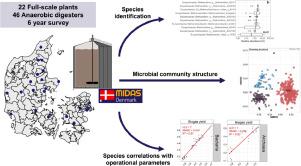Water Research ( IF 11.4 ) Pub Date : 2021-01-25 , DOI: 10.1016/j.watres.2021.116871 Chenjing Jiang , Miriam Peces , Martin Hjorth Andersen , Sergey Kucheryavskiy , Marta Nierychlo , Erika Yashiro , Kasper Skytte Andersen , Rasmus Hansen Kirkegaard , Liping Hao , Jan Høgh , Aviaja Anna Hansen , Morten Simonsen Dueholm , Per Halkjær Nielsen

|
Anaerobic digestion (AD) is a key technology at many wastewater treatment plants (WWTPs) for converting primary and surplus activated sludge to methane-rich biogas. However, the limited number of surveys and the lack of comprehensive datasets have hindered a deeper understanding of the characteristics and associations between key variables and the microbial community composition. Here, we present a six-year survey of 46 anaerobic digesters, located at 22 WWTPs in Denmark, which is the first and largest known study of the microbial ecology of AD at WWTPs at a regional scale. For three types of AD (mesophilic, mesophilic with thermal hydrolysis pretreatment, and thermophilic), we present the typical value range of 12 key parameters including operational variables and performance parameters. High-resolution bacterial and archaeal community analyses were carried out at species level using amplicon sequencing of >1,000 samples and the new ecosystem-specific MiDAS 3 reference database. We detected 42 phyla, 1,600 genera, and 3,584 species in the bacterial community, where 70% of the genera and 93% of the species represented environmental taxa that were only classified based on MiDAS 3 de novo placeholder taxonomy. More than 40% of the bacterial species were found not to grow in the mesophilic and thermophilic digesters and were only present due to immigration with the feed sludge. Ammonium concentration was the main driver shaping the bacterial community while temperature and pH were main drivers for the archaea in the three types of ADs. Sub-setting for the growing microbes improved significantly the correlation analyses and revealed the main drivers for the presence of specific species. Within mesophilic digesters, feed sludge composition and other key parameters (organic loading rate, biogas yield, and ammonium concentration) correlated with specific growing species. This survey provides a comprehensive insight into community structure at species level, providing a foundation for future studies of the ecological significance/characteristics and function of the many novel or poorly described taxa.
中文翻译:

表征丹麦污水处理厂46个厌氧消化池中物种水平上正在生长的微生物:一项为期六年的微生物群落结构和关键驱动因素调查
厌氧消化(AD)是许多废水处理厂(WWTP)的一项关键技术,用于将原始和剩余的活性污泥转化为富含甲烷的沼气。但是,调查数量有限以及缺乏全面的数据集,阻碍了人们对关键变量与微生物群落组成之间的特征和关联的更深入的了解。在这里,我们对位于丹麦的22个污水处理厂的46个厌氧消化池进行了为期6年的调查,这是对污水处理厂在区域范围内的AD微生物生态学的第一个也是最大的已知研究。对于三种类型的AD(中温,热水解预处理的中温和嗜热的),我们给出了12个关键参数的典型值范围,包括操作变量和性能参数。使用超过1,000个样品的扩增子测序和新的生态系统特定的MiDAS 3参考数据库,在物种水平上进行了高分辨率细菌和古细菌群落分析。我们在细菌群落中检测到42种门,1,600个属和3,584个物种,其中70%的属和93%的物种代表仅根据MiDAS 3分类的环境分类单元从头占位符分类法。发现超过40%的细菌物种不在嗜温和嗜热消化池中生长,仅由于与进料污泥一起迁移而存在。铵浓度是影响细菌群落的主要驱动力,而温度和pH值是三种AD中古细菌的主要驱动力。对正在生长的微生物进行亚设置可显着改善相关性分析,并揭示特定物种存在的主要驱动因素。在中温消化池中,饲料污泥的组成和其他关键参数(有机负荷率,沼气产量和铵浓度)与特定的生长物种相关。这项调查提供了对物种一级社区结构的全面了解,











































 京公网安备 11010802027423号
京公网安备 11010802027423号